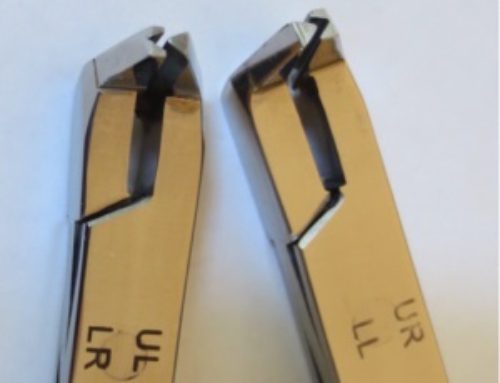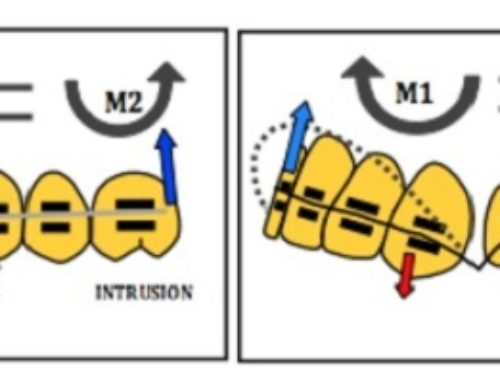POSSIBLE NiTi WIRES BENDS BY BENDISTAL AND OMNI PLIERS
The following v bends on round and rectangular super elastic wires are:
- Bending the distal ends of super elastic arch wires intra-orally without annealing or over twisting the wires;
- Customize arch wires into mushroom shaped wires for lingual orthodontics;
- Makes step in/out bends;
- Makes step up/down bends;
- Place v-bends on arch wires extra-orally, and intra-orally to tip back molars, and intrude or extrude teeth.

Figure. 5, Samples of types of v- bends possible in super elastic archwires. Viewer’s Left, Shows vertical bends: cinch back, step up. Step down, and intrusion bends. Middle Shows transvers bends: step out, step in, and mushroom bends. Viewer Right, Shows cross bite midline expanding bend, and constricting bends.

Figure 6. A. Shows possibility of placing intraoral bends in distal end, and molars tip back bends in NiTi archwires. B. Shows the effect of intraoral intrusive v bends behind canine areas of archwires. In this case the activated archwire was left acting on both dental arches for extended period, resulting in opening the overbite much more than what needed. C. Shows insertion of the intrusive v bends in both maxillary and mandibular archwires that will intrude and disengage the deep anterior crossbite, which will allow mandibular incisors retraction and class III treatment
PROPER BENDING PROCESS IN STRAIGHT NITI WIRES
The Bendistal and Omni Pliers jaws can insert optimally angled permanent, and effective v-bends, when properly related to the wire.
Extra caution during bending of these wires with the new plier’s jaw shape is requires. Generally speaking, round NiTi wires slip more easily than rectangular wires during bending to avoid a wrong gripping angle to the wire. The following principles insure a correct bend:
- Clinicians must grab the wire at a right angle with the plier’s snout. This angle provides better grip control and should continue until the plier’s jaws completely close. This produces a bend in the same plane and in line to the rest of the wire.
- Clinicians cannot correct inaccurate bends angle in super elastic wires. Attempts to change the wrong bend will break the archwire.
- While the cross-sectional shape of rectangular wires provides a sturdier grip on wires before bending, clinicians must use extra caution when bending round wires because of their easier slippage.

Fig. 3. A, to the left, shows a wrong non-perpendicular wire/snout angle relation when the UL-LR pliers’ occlusal jaw is placed under the wire during the bending process. The direction of the bent part of the wire (in red) is deflected away from wire’s straight line. B shows the opposite wrong angle of the pliers’ jaws to the wire, which deflects the bent wire part (in red) away from the rest of the wire’s straight line as well. C shows the correct 90-degree angle of wire to snout relationship that directs the bent part of the wire in line with the rest of the wire.
PROPER BENDING PREFORMED NITI ARCHWIRES
When bending preformed archwires, the following principles produce correct activation, in all kinds of NiTi as well as stainless steel archwires.
- In addition to the 90° angle of the plier’s snout to wire line, the snout jaws should also be in line with the imaginary plane of the preformed archwire. This ensures the bent part of the wire will deflect in a plane perpendicular to archwire’s plane Fig.4.
- Pointing the tip of jaws down or up to the archwire plane will incorrectly deflect the bend.
- So only correct right–angled grip of the wire, with the snout in line with the arch wire plane, provides predictable activating v-bends.

Fig. 4. Shows intrusive v-bends on preformed archwires. A. When the occlusal jaw of (Bendistal, or the lower occlusal jaw of Omni pliers), lies under the arch wire, and the snout makes an obtuse angle to the wire line, the v-bend deflects round wire up, out and, in a wrong plane in yellow, not vertical to the arch wire plane in blue. B. An acute snout angle to the wire deflects it up, in, and not vertical to the arch wire plane. C. The correct right angle between snouts to wire, will deflect the wire correctly, vertical plane archwires plane. For horizontal v-bends, e.g., step-in, step-out and cross bite midline bends, the snout of the plier’s jaws should make a right angle with the imaginary plane of the preformed arch wire, otherwise the wire deflection will cause an unwanted extrusion or intrusions of the affected teeth.



Leave A Comment